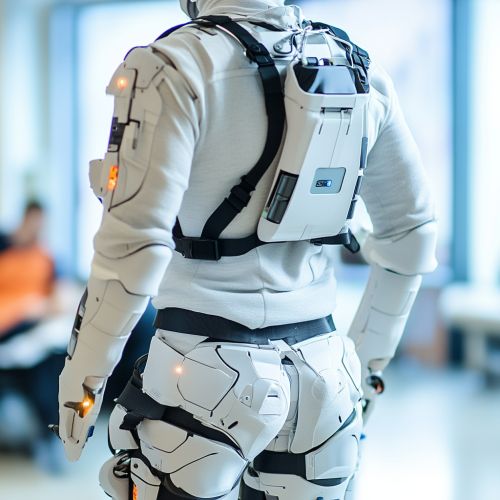Rehabilitation Engineering: Difference between revisions
(Created page with "== Introduction == Rehabilitation engineering is a multidisciplinary field that applies engineering principles and design concepts to develop solutions for individuals with disabilities. This domain integrates knowledge from biomechanics, biomedical engineering, computer science, and rehabilitation medicine to enhance the quality of life and functional capabilities of people with physical and cognitive impairments. Rehabilitation engineering encompasses...") |
No edit summary |
||
| Line 21: | Line 21: | ||
Robotics and mechatronics play a crucial role in rehabilitation engineering, particularly in the development of [[exoskeletons]] and robotic-assisted therapy devices. These systems are designed to support and enhance human movement, providing assistance during rehabilitation exercises or enabling mobility for individuals with severe impairments. Research in this area focuses on improving the adaptability, efficiency, and user-friendliness of robotic systems. | Robotics and mechatronics play a crucial role in rehabilitation engineering, particularly in the development of [[exoskeletons]] and robotic-assisted therapy devices. These systems are designed to support and enhance human movement, providing assistance during rehabilitation exercises or enabling mobility for individuals with severe impairments. Research in this area focuses on improving the adaptability, efficiency, and user-friendliness of robotic systems. | ||
[[Image:Detail-98491.jpg|thumb|center|An advanced robotic exoskeleton designed for rehabilitation purposes, worn by a person in a clinical setting.|class=only_on_mobile]] | |||
[[Image:Detail-98492.jpg|thumb|center|An advanced robotic exoskeleton designed for rehabilitation purposes, worn by a person in a clinical setting.|class=only_on_desktop]] | |||
=== Human-Computer Interaction === | === Human-Computer Interaction === | ||
Latest revision as of 23:41, 16 October 2024
Introduction
Rehabilitation engineering is a multidisciplinary field that applies engineering principles and design concepts to develop solutions for individuals with disabilities. This domain integrates knowledge from biomechanics, biomedical engineering, computer science, and rehabilitation medicine to enhance the quality of life and functional capabilities of people with physical and cognitive impairments. Rehabilitation engineering encompasses the development of assistive devices, prosthetics, orthotics, and adaptive technologies tailored to meet the specific needs of users.
Historical Background
The origins of rehabilitation engineering can be traced back to the aftermath of World War II, when the need to rehabilitate injured soldiers led to significant advancements in prosthetics and orthotics. The field gained formal recognition in the 1970s with the establishment of the Rehabilitation Engineering Society of North America (RESNA). Since then, the discipline has evolved, driven by technological innovations and a growing understanding of human physiology and biomechanics.
Core Areas of Rehabilitation Engineering
Assistive Technology
Assistive technology refers to devices or systems that aid individuals with disabilities in performing tasks that might otherwise be difficult or impossible. These technologies range from simple tools like canes and walkers to complex systems such as speech-generating devices and environmental control systems. The design and implementation of assistive technology require a deep understanding of user needs, ergonomic principles, and the integration of electronic and mechanical components.
Prosthetics and Orthotics
Prosthetics involves the design and fabrication of artificial limbs to replace missing body parts, while orthotics focuses on creating devices that support or correct musculoskeletal deformities. Advances in materials science, such as the use of lightweight composites and 3D printing, have revolutionized the field, allowing for more customized and functional solutions. Modern prosthetics often incorporate microprocessors and sensors to enhance movement and control.
Robotics and Mechatronics
Robotics and mechatronics play a crucial role in rehabilitation engineering, particularly in the development of exoskeletons and robotic-assisted therapy devices. These systems are designed to support and enhance human movement, providing assistance during rehabilitation exercises or enabling mobility for individuals with severe impairments. Research in this area focuses on improving the adaptability, efficiency, and user-friendliness of robotic systems.


Human-Computer Interaction
Human-computer interaction (HCI) in rehabilitation engineering involves designing interfaces and systems that facilitate communication and interaction for individuals with disabilities. This includes the development of eye-tracking systems, brain-computer interfaces, and adaptive software that can be controlled through alternative input methods. The goal is to create intuitive and accessible technologies that empower users to interact with digital environments effectively.
Design and Development Process
The design and development process in rehabilitation engineering is user-centered, emphasizing the importance of understanding the specific needs and preferences of individuals with disabilities. This process typically involves several stages:
1. **Needs Assessment:** Identifying the functional limitations and goals of the user. 2. **Conceptual Design:** Developing initial design concepts based on user requirements and constraints. 3. **Prototyping:** Creating physical or digital prototypes to test and refine design ideas. 4. **User Testing:** Conducting trials with end-users to evaluate the effectiveness and usability of the prototypes. 5. **Iterative Refinement:** Making necessary adjustments based on feedback and testing results. 6. **Implementation:** Finalizing the design and producing the device or system for use.
Ethical and Social Considerations
Rehabilitation engineering raises several ethical and social considerations, including issues related to accessibility, affordability, and user autonomy. Engineers must ensure that their designs are inclusive and do not inadvertently create barriers for certain user groups. Additionally, there is a need to address the cost of assistive technologies, making them accessible to individuals from diverse socioeconomic backgrounds. Privacy and data security are also critical concerns, particularly when developing systems that collect and process personal information.
Future Directions
The future of rehabilitation engineering is poised for significant advancements, driven by emerging technologies such as artificial intelligence, machine learning, and nanotechnology. These innovations hold the potential to create more adaptive and intelligent systems that can better respond to the dynamic needs of users. Furthermore, interdisciplinary collaboration between engineers, clinicians, and researchers will continue to play a vital role in advancing the field and improving outcomes for individuals with disabilities.
